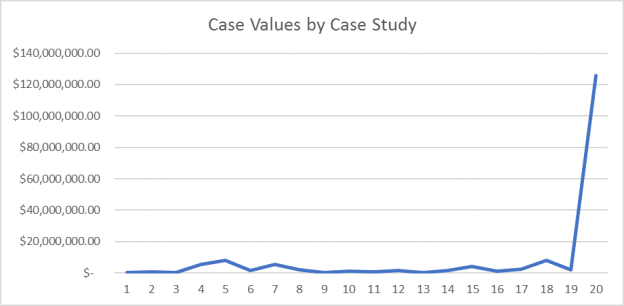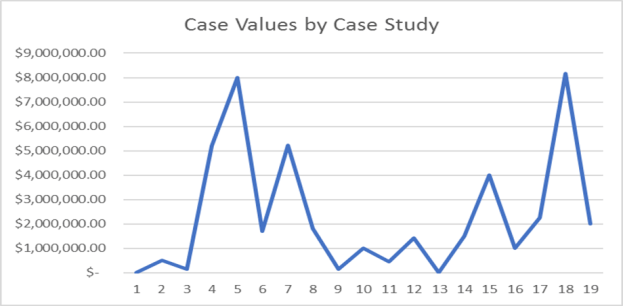From a 20-case jury verdict research sample of above-the-elbow amputation cases across the State of Florida, we saw 6 high-value outliers: $4 million, $5.2 million, $5,227,708, $8 million, $8,156,219, and the highest outlier of $125,820,044. Based on the distribution of case values in this data set, we determined that any value of $4-million-dollars and over would be included as an outlier in the analysis of this sample. Specifically, when looking at Figure 1 and Figure 2, you can easily point out the outliers from the normal trend of values in the sample.

Figure 1. In this line graph, you can see the highest outlier relative to all other values in the sample.

Figure 2. In this line graph, we removed the $125 million-dollar outlier to show the other outliers in relation to the normal trend of values in the sample.
Outliers in statistics expose values that go far above (or below) the average of a data set. Mostly, these outliers tell a researcher to look at a specific data point to determine why that point would stray from the ordinary trend of values in that set. In jury verdict research particularly, outliers direct anyone analyzing jury verdict research to a case to analyze the facts of that case and to look further into the details of the case, and determine why that case received a higher verdict, or settlement in a jury trial setting, than another similar case. High-value outliers must be studied in terms of their ability to skew the average of a data set from their extraordinarily high value. It’s important to always calculate averages with and without the outliers for the most representative average of a data set.
In looking at the above-elbow amputation case sample, the data with outliers generally have explanatory situations that set them apart from the overall trend of the other cases in the sample. To demonstrate this, let’s look at a few examples from the sample.
In Case Study 15, we saw an 88-year-old female plaintiff who was stopped at an intersection waiting to cross the street. As the light turned green, the defendant, who had been stopped and was waiting to make a turn in his tractor-trailer, began his wide turn. The plaintiff started to walk forward around the same time that the defendant was making his turn. She was then struck and the rear wheels of the tractor-trailer ran over her arms. The plaintiff later stated that she didn’t think the truck was turning; however, the defendant claimed that the plaintiff walked into the truck. Two eyewitnesses also claimed that the plaintiff began walking after the truck was blocking the crosswalk. The plaintiff was hospitalized for approximately three months, underwent multiple surgeries, and will require 24-hour care for the rest of her life due to her amputation. This case was resolved with a comparative negligence verdict of $4 million dollars with 50% negligence assigned to the plaintiff and 50% to the defendant and co-defendant, the defendant’s employer. The award was reduced to $2 million dollars.
Case Study 18 involved a 21-year-old male plaintiff who brought about a product liability claim after he was injured by a wood chipper manufactured by the defendant and marketed and sold under the name of the second-named defendant. On the day of the accident, the plaintiff was feeding branches into the chipper when his gloved right hand became caught in the branches. Before he could pull his hand out or activate the stop/reverse bar, he was drawn into the machine. Co-workers were not able to stop the machine and reverse it before the plaintiff lost his entire right arm. Normally, the distance from the infeed chute, where the material goes in, and the nip point, where the chipping action happens, is at least longer than the length of a man’s arm; however, the unit in question had a twenty-inch infeed chute, which was much shorter than the total length of the arm causing the arm to be sucked into the nip point. At trial, the plaintiff claimed that the second-named defendant, who had previously manufactured and sold a successful wood chipper, should have insisted that the defendant’s unit being sold under the second-named defendant’s name contain the same safety margin of an infeed chute that is longer than an arm’s length. The units the second-named defendant had successfully manufactured had an infeed chute of approximately sixty inches. Both defendants contended that the unit was dangerous to operate, but the twenty-inch infeed chute length was reasonable. The defendants further claimed that the plaintiff was neglectful in reaching into the unit to feed in short material, but their 1988 sales video showed the president of the company sticking his hand into the machine sixteen times in two minutes. Therefore, the plaintiff claimed that the defendant manufacturer knew the design was unsafe, that users would be constantly reaching into the unit, and that the infeed chute needed to be at least fifty to sixty inches. The jury found the plaintiff not negligent and both defendants negligent with 40% negligence assessed to the manufacturer and 60% negligent assessed to the seller. This case was resolved with a plaintiff’s verdict for $8,156,219.
To learn more about the value attributed to all above-the-elbow amputation cases,please see our other blogs.
If you’re a potential client, or an attorney seeking a second opinion, and would like to discuss the value of your case please feel free to call us anytime at (850)-244-3310.





